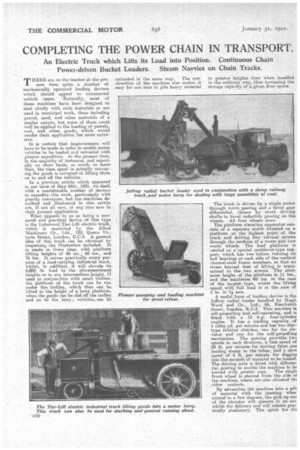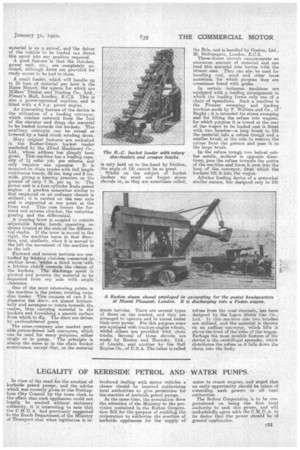COMPLETING THE POWER CHAIN IN TRANSPORT.
Page 30

Page 31

If you've noticed an error in this article please click here to report it so we can fix it.
An Electric Truck which Lifts its Load into Position. Continuous Chain Power-driven Bucket Loaders. Steam Navvies on Chain Tracks.
THERE are on the' market at the present time quite a number of mechanically operated loading devices which should appeal to commercial vehicle users. Naturally, most of these machines have been designed to deal chiefly with such materials as are used in municipal work, these including gravel, sand, and other materials of a similar nature, but some of them could well be applied to the loading of parcels, coal, and other goods' which would render their application far more extensive.
It is certain that improvements will have to be made in order to enable motor vehicles to be loadedand unloaded with greater expedition. At the present time, in the majority of instances, and especially on short hauls, as much, or more than the time spent in actually conveying the goods is occupied in lifting them on to and off the vehicles.
In a previous article which appeared in our issue of May 24th, 1921, we dealt with a considerable number of devices to expedite this work, particularly with gravity conveyors, but the machines described and illtistrated in this article are, if not all new, at any rate new in their present application.
What appeals to us as being a mos' novel and practical device of this type is the Lakewood Tier-Lift electric truck, which is marketed by the Allied Machinery Co., Ltd., 132, Queen Victoria Street, London, E.C.4. A general idea of this truck can be obtained by inspecting the illustration included. It is made in three sizes, with platform lifting heights of 42 ins., 60 ins., and 76 ins. It serves practically every purpose of a load-carrying industrial truck, whilst, in addition, it will elevate its 4-,003 lb. load to the aforementioned heights or to any intermediate height. If used in conjunction with .small trollies, the platform of the truck can be run under the trollie,s, which then can be lifted to the height of a lorry platform, when the goods can be slid off the trolley and on to the lorry; -vehicles,can be
unloaded in the same way. The construction of the machine also makes. it easy for one man to pile heavy material
to greater heights than when handled in the ordinary way, thus increasing the storage capacity of a given floor apace.
The truck is driven by a single motor through worm gearing and a bevel gear differential, thence by short driving shafts; to bevel reduction gearing on the wheels. All four wheels steer.
The platform elevating apparatus consists of a separate motor situated on a platform at the highest point of the truck and driving two vertical screws through the medium of a worm and two worm wheels. The load platform is carried on a-special cantilever-type support, which has two 'rollers running on ball bearings at each side of the vertical channel-steel frame members, so that no stress beyond that of lifting is transmitted to the two screws. The minimum height of the platform is 11 ins., and the maximum 60 ins, in the case of the largest type, whilst the lifting speed with full load is at the rate of Um. in 1i secs.
A useful form of loading deviate is the Jeffrey radial loader handled by Hugh Wood and Co., Ltd., 65, Fenchureh Street, London, E,C.3. This machine is self-propelling and self-operating, and is fitted with a 15 h.p. four-cylinder engine. It has a loading capacity of 1 cubic yd. per minute and has two disctype friction clutches, one for the elevator and one for the self-propelling mechanism. The gearing provides two speeds in each direction, a fast speed of it. per minute for moving from one loading dump to the other, and a slow speed of 4 ft. per minute for digging into the mounds of material to be loaded. The driving axle is fitted with differential gearing to enable the machine to be turned with greater ease. The single front wheel is steered from the side of the machine, where are also situated th( other controls.
By advancing the machine into e,pil( of material with the steering wbei turned to a few degrees, the pick-up ens of the elevator will operate in an arc whilst the delivery and will remain prac tically stationary. The spout for tin material is on a swivel, and -the driver of the vehicle to be loaded can direct this spout into any position required. A good feature is that the clutches, power unit, etc., are completely enclosed, although doers are provided for ready accessto be had to them.
A small loader, which will handle up to 25 tons of material per hour is the Haiss Mascot, the agents for which are Millers' Timber and Trading Co., Ltd., Pinner's Hall, London, E.C.a This is also a power-operated machine. and is etted with a 4 hp. petrol engine.
An interesting feature of the device is the utilization of a feeding conveyor, which reaches outward from the foot of the elevator and drags the material to be loaded towards the buckets. This auxiliary conveyor can be raised or lowered by a hails{ crank winding drum.
Many original features are embodied in the Barber-Green bucket loader marketed by the Allied Machinery Co., Ltd., whose address has already been given. This machine has a loading capacity of le cubic yds. per minute, and only requires one operator. It is mounted on chain tracks with full length continuous treads, 58 ins, long and 8 ins. wide, giving a bearing pressure on the ground of only 7 lb. per sq. in. The power unit is a-four-cylinder Buda petrol engine. A gearbox somewhat similar to that employed on an ordinary chassis is utilized ; it is carried on the rear axle and is supported at one point at the front end. This case houses the forward and reverse clutches the reduction gearing and the differential.
A steering lever is coupled to outside adjustable brake bands operating en drums located at the ends of the differential shafts. If the lever is moved to the right, the machine turns in that direction, and, similarly, when it is moved to the left the movement of the machine is to the left.
Forward and reverse motions are controlled by friction clutches connected to another lever, whilst a third lever with a friction clutch controls the -chains of the buckets. The discharge spout is pivoted and permits the material to be deposited from any side with ample clearance.
One of the most interesting points in the machine is the patent rotating twindisc feeder. This omelets of two 3 ft. diameter flat die's. set almost horizontally and arrangedso rotate towards the centre, thus carrying material to the buckets and furnishing a smooth surface from which to dig. The discs are driven by e-aclosedibevel gears: The sarne..company also market pore able.power-driven belt conveyors, which can be used for many purposes, either singly or in gangs. The principle is almost the same as in the chain bucket contrivance, except that, as the materiel
is only held on to the band by friction, the angle of lift cannot be so great. Whilst on the subject of bucket loaders we must not forget steam shovels or, as they are sometimes called, steam navvies. There are several types of these on the market, and they are arranged to operate and to travel under their own power. For this purpose some are equipped wifh traction-engine wheels, whilst others are provided with chain tracks. Several of these shovels are made by Ruston and Hornsby, Ltd., of Lincoln, and. another •by the Ball Engine Go., of U.S.A. The latter is called the Erie, and is handled by Gaston, Ltd., 20, Bishopsgate, London, E.C.2.
These st e am shovels can s ex oayate an enormous amount of material and can load this material into lorries with the utmost ease. They can also be used for handling coal, sand and other loose materials, for which purpose they are sometimes fisted with grabs.
In certain instances machines are equipped with a loading arrangement in which the loading forms only one of a chain of operations. Such a machine is the Pioneer sweeping and loading machine made by F. Walters and Co., of Rugby; it is intended for street sweeping and for lifting the refuse into wagons, for which purpose it is towed at the rear of the wagon to be loaded and is fitted with two brushes—a long brush to lift the material into a refuse trough and a smaller brash at the side to remove the refuse from the gutters and pass it to the large" brush.
14 the refuse trough two helical rubber scrolls, inclined in opposite directions, pass the refuse towards the centre of the machine and force it over into the boot of the conveyor, from which the buckets lift it into the wagon.
Mother loading device of a somewhat similar nature, but designed only to lift refuse from the road channels, has been designed by the Lacre Motor Car Co., Ltd. In this .machine also two brushe are utilized, and the material is thrown on an endless conveyor, which lifts it above the level of the sides of the wagon. Perhaps the most notable feature of the device is the centrifugal spreader, which distributes the refuse as it falls down the chute into the body.




































